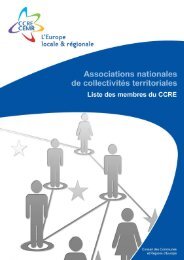Complementarities between urban and rural areas in promoting ...
Complementarities between urban and rural areas in promoting ...
Complementarities between urban and rural areas in promoting ...
Create successful ePaper yourself
Turn your PDF publications into a flip-book with our unique Google optimized e-Paper software.
COMPLEMENTARITIES BETWEEN URBAN AND RURAL AREAS IN PROMOTING EMPLOYMENT AND SOCIAL INCLUSIONbeh<strong>in</strong>d this concept was to establish the partnershipdur<strong>in</strong>g these six months <strong>in</strong> order todevelop a jo<strong>in</strong>t strategy, to mutually def<strong>in</strong>e thenature of the problem, <strong>and</strong> to assess whatoptions for solutions <strong>and</strong> resources exist <strong>and</strong>how they can be mobilised. The first <strong>in</strong>stance ofthis process was undertaken <strong>between</strong> November2001 <strong>and</strong> May 2002.EQUAL is built on the pr<strong>in</strong>ciples of transnationality,partnership <strong>and</strong> empowerment. In additionthere is also the pr<strong>in</strong>ciple of <strong>in</strong>novation whichmeans that one has to f<strong>in</strong>d new ways of organis<strong>in</strong>g<strong>and</strong> connect<strong>in</strong>g work with other aspects oflife: a new means of work<strong>in</strong>g which facilitates abalance <strong>between</strong> family life, leisure, tra<strong>in</strong><strong>in</strong>g <strong>and</strong>work is be<strong>in</strong>g <strong>in</strong>itiated. F<strong>in</strong>ally an important elementthat has to be <strong>in</strong>tegrated from the beg<strong>in</strong>n<strong>in</strong>gis ma<strong>in</strong>stream<strong>in</strong>g, that is to say the <strong>in</strong>tegrationof what has been learnt should be put<strong>in</strong>to practice at every level. Under ADAPT, therewere a number of projects <strong>in</strong> the field of jobrotation. This was first developed <strong>in</strong> Denmarkwhere unemployed people are recruited for alimited period of time to work <strong>in</strong> companies, ona temporary basis, to replace exist<strong>in</strong>g staff whowere be<strong>in</strong>g tra<strong>in</strong>ed. This aga<strong>in</strong> is an <strong>in</strong>terface ofhow to comb<strong>in</strong>e those <strong>in</strong>stitutions deal<strong>in</strong>g withunemployed people <strong>and</strong> those <strong>in</strong>stitutions thatdeal with tra<strong>in</strong><strong>in</strong>g, as well as how to f<strong>in</strong>d fund<strong>in</strong>garrangements comb<strong>in</strong><strong>in</strong>g the two. Differenttypes of models have been applied to small companies,large companies, <strong>and</strong> to <strong>urban</strong>ised <strong>rural</strong><strong>areas</strong>. These experiments have been successfulwhere they have found a way to validate theresults <strong>and</strong> discovered an approach to overcom<strong>in</strong>gthe obstacles <strong>in</strong> the current legislativeregime. In some member states, platforms <strong>and</strong>associations were formed to lobby parliamentarians.This <strong>in</strong> turn resulted <strong>in</strong> new legislation, forexample <strong>in</strong> Portugal, Italy <strong>and</strong> Germany.WHAT HAS BEEN ACHIEVED SO FAR?In the first round of the EQUAL <strong>in</strong>itiative, memberstates who implement this programme haveselected 1,500 development partnerships <strong>in</strong> n<strong>in</strong>ethematic fields which were agreed upon bymember states as be<strong>in</strong>g problem <strong>areas</strong> where itis necessary to cooperate <strong>and</strong> to learn from oneanother. Between November 2001 <strong>and</strong> spr<strong>in</strong>g2002, 1,500 development partnerships havebeen established. They have developed a strategy<strong>and</strong> have agreed on a work plan that commits allpartners for the next two years. Thematicallyspeak<strong>in</strong>g, there is a concentration on the facilitationof access to the labour market, especiallyfor the long-term unemployed. More than halfof these partnerships are regional or local partnerships,which means that they all work <strong>in</strong> thesame region <strong>and</strong> they tackle a specific problemthat is evident <strong>in</strong> one of these regions. Approximatelyten partners work together <strong>in</strong> each of thepartnerships <strong>and</strong> most of them <strong>in</strong>clude a local orregional authority, one or more have strategic oroperational partners, <strong>and</strong> a number of them havemanaged to <strong>in</strong>clude NGOs. In addition, platformshave been set up for the validation of experience<strong>and</strong> for the identification of good practice alreadyimplemented. It is <strong>in</strong>tended that European networks,where the coord<strong>in</strong>ators of the partnershipsmeet organisations work<strong>in</strong>g at Europeanlevel, work together on a number of specificissues which are relevant to the political agenda.These platforms are also <strong>in</strong>tended to provide anexchange of best practice. Different memberstates have different experiences. Some of themare outside EQUAL <strong>and</strong> the Commission is try<strong>in</strong>gto <strong>in</strong>tegrate these <strong>in</strong> order to facilitate progress.It should not be forgotten that although EQUALrepresents only 5 percent of the European StructuralFund <strong>in</strong> absolute terms, this programmeaccounts for around 3 billion euro. Complementarynational fund<strong>in</strong>g also exists.— 20 —



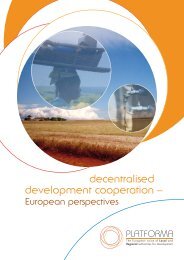

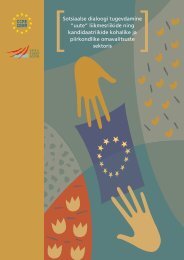
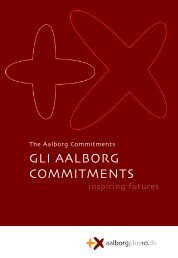





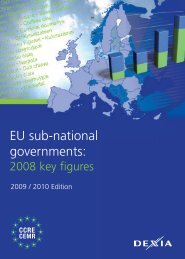
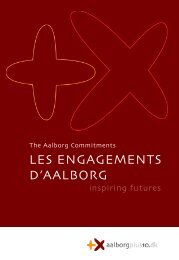
![[ ] Les jumelages pour le monde de demain](https://img.yumpu.com/29721946/1/190x96/-les-jumelages-pour-le-monde-de-demain.jpg?quality=85)

